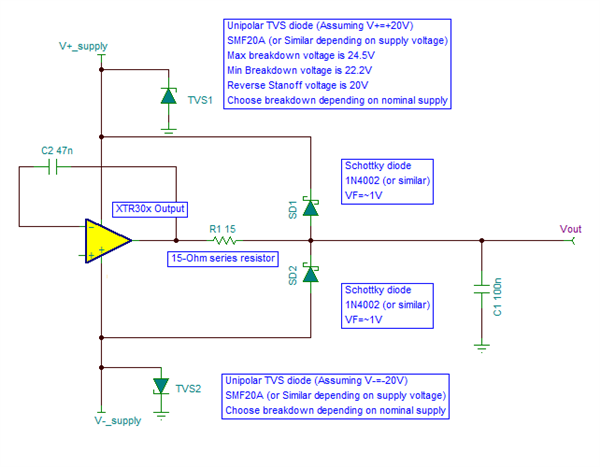Hi,
What's the maximum voltage the output DRV pin could bear for XTR300? Thanks.
Best Regards,
Tess Chen
This thread has been locked.
If you have a related question, please click the "Ask a related question" button in the top right corner. The newly created question will be automatically linked to this question.
Hi,
What's the maximum voltage the output DRV pin could bear for XTR300? Thanks.
Best Regards,
Tess Chen
Hi Tess,
A conservative approach is to limit the maximum voltage of the XTR300 output to ~0.5V above/below the supply rails during a fault, in other words, (V-) -0.5V < VOUT < (V+) +0.5V to avoid the internal ESD structures turning on, since the internal ESD output protection structures of the device will start to turn on around ~0.55V (start to turn on above/below the supplies depending on temperature); they will be fully on at ~0.7V. The output can withstand a peak output current of 50mA.
It is recommended to use an external protection clamp circuit to protect the output stage on an industrial environment.
For example, when designing an XTR300 output external protection clamp circuit, using a series resistor combined with external Schottky diodes to the rail supplies and a capacitor at the output will work. On the example protection circuit below, assuming the Schottky diode has a forward voltage of ~1-V during the fault condition, the internal XTR300 ESD output structure will start to turn on at 0.55V above the supply. Assuming the external diode forward voltage is typically ~1V above the supply during the fault, the current at the output ESD structure will be limited to (1V - 0.55V) / 15-Ohm = 30mA. I also recommend to use external TVS diodes at the (V+) and (V-) supplies to ensure the supply voltage is also clamped as well. The designer needs to select the supply TVS diode clamping voltage depending on the nominal voltage on the supplies. The 100nF capacitor at the output helps protect against high voltage transients. See one example of an output protection clamp circuit on the figure below, where the device is powered with bipolar Vs= +/-20V supplies.
Thank you and Regards,
Luis
